at the round earth's imagined corners...
Round Earth's Imagined Corners takes its name from a line in John Donne's Holy Sonnet 7. I had used it as the title for a solo exhibit (1981) where each drawing and painting brought together disparate images in a corner composition. For this video, three pieces of my earlier work - Vertical Run (1970) Handling The Large Comfit (1972) and Tablesaw Skyscape (1976) - were reconstructed digitally and animated using Pansophic Studioworks running on an AT286 desktop computer equipped
with Targa16. The work was commissioned by the Centre for Art Tapes for the exhibition New Tools for Imaging (1990) and was completed in the, then titled, Centre for Computer Graphics & Animation at NSCAD University. Later that same year, Round Earth's Imagined Corners was selected for screening at the Second International Symposium on Electronic Art in Groningen, Holland.
Thanks are due to alto-saxophonist Paul White who composed and recorded a soundtrack in real-time while watching the video; and to Andy Dowden who provided technical advice and support with the audio that is digitally-manipulated analogue sound.
For those who are familiar with the sophistication of current computer animation, Round Earth's technical problems are more than a little noticeable. Objects break apart as they move off screen and movement is occasionally erratic and uneven. Many sequences had to be rebuilt after I saw the result of overnight processing that may have generated no more than five seconds of wireframe animation. Such was the state of the desk-top software in the late 1980s where processing was painfully slow and time-code discrepancies seemed virtually impossible to control. As to the resolution, what you now see on-screen is fourth-generation: 3/4" videotape source, to 1/2" tape, to dvd via compression to the website. High resolution it is not. As a record of Round Earth's Imagined Corners, it is what it is. But, even with the technological challenges, participating in this project was a genuine privilege.
If you watch the video, you will see a moment at the end where the cube is rotating and a three-quarter view reveals the objects nestled in the room. That one frame pleases me a lot - almost enough to justify the time, energy and effort that went into creating this flawed piece of animation.
Thanks are due to alto-saxophonist Paul White who composed and recorded a soundtrack in real-time while watching the video; and to Andy Dowden who provided technical advice and support with the audio that is digitally-manipulated analogue sound.
For those who are familiar with the sophistication of current computer animation, Round Earth's technical problems are more than a little noticeable. Objects break apart as they move off screen and movement is occasionally erratic and uneven. Many sequences had to be rebuilt after I saw the result of overnight processing that may have generated no more than five seconds of wireframe animation. Such was the state of the desk-top software in the late 1980s where processing was painfully slow and time-code discrepancies seemed virtually impossible to control. As to the resolution, what you now see on-screen is fourth-generation: 3/4" videotape source, to 1/2" tape, to dvd via compression to the website. High resolution it is not. As a record of Round Earth's Imagined Corners, it is what it is. But, even with the technological challenges, participating in this project was a genuine privilege.
If you watch the video, you will see a moment at the end where the cube is rotating and a three-quarter view reveals the objects nestled in the room. That one frame pleases me a lot - almost enough to justify the time, energy and effort that went into creating this flawed piece of animation.

